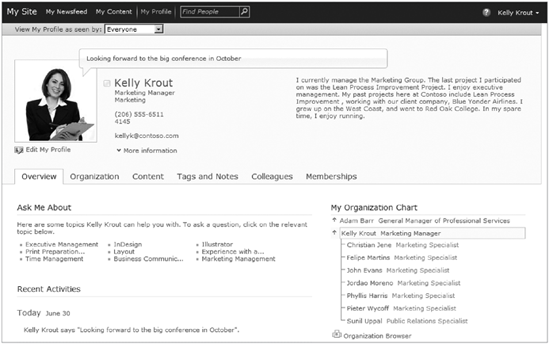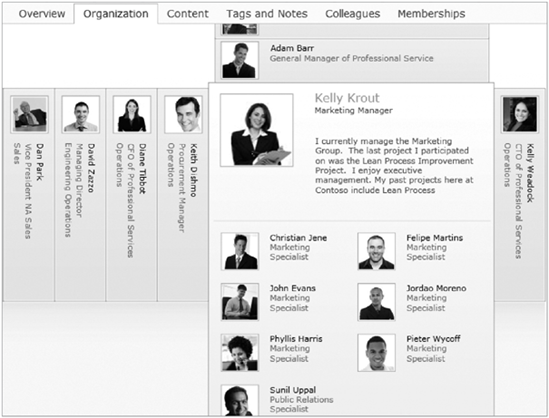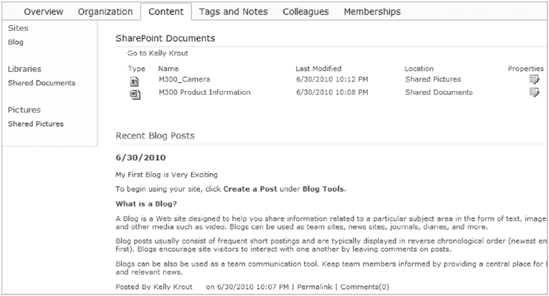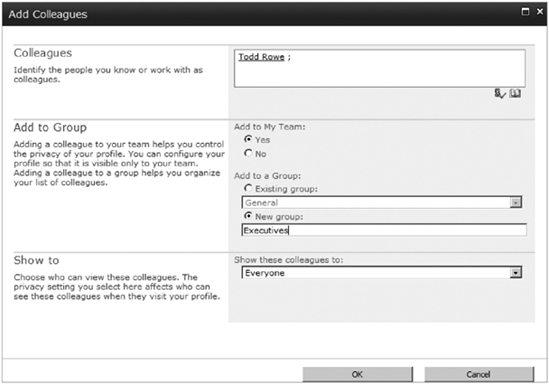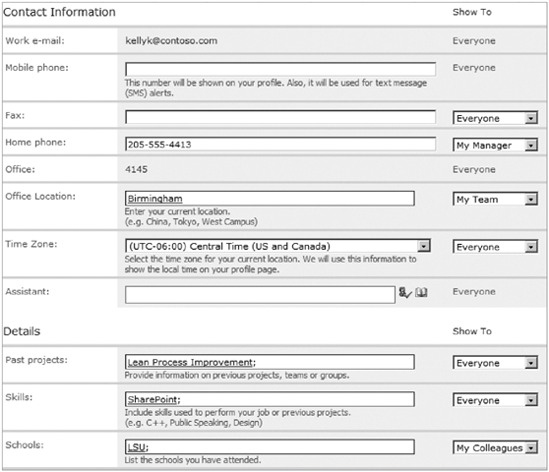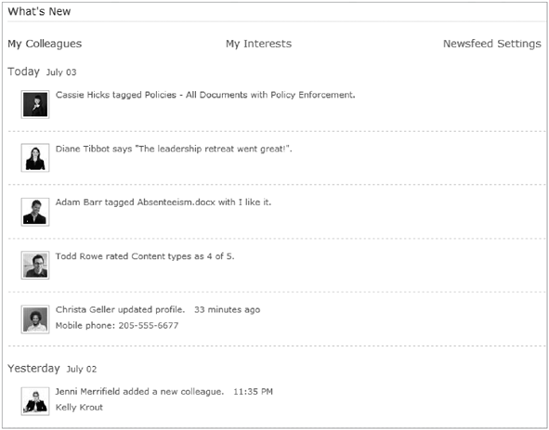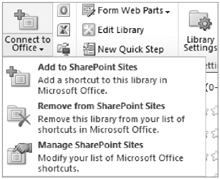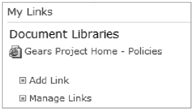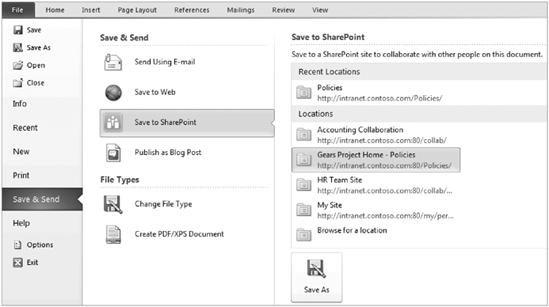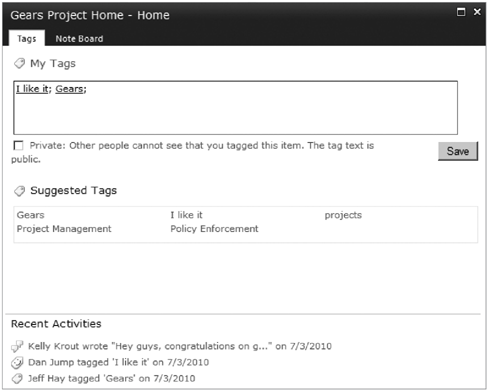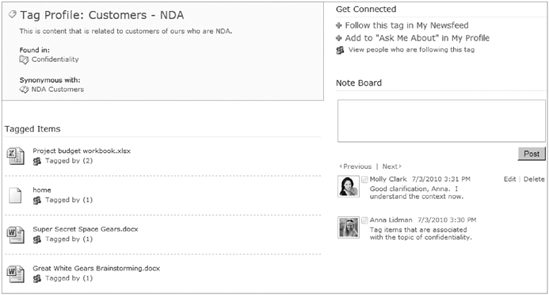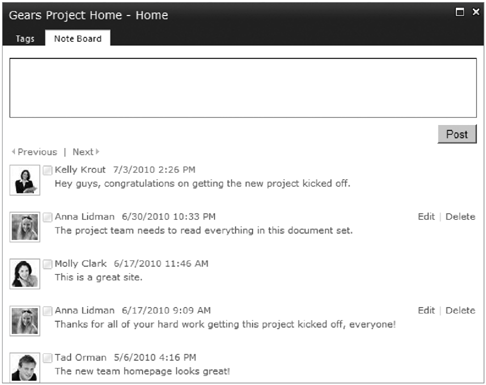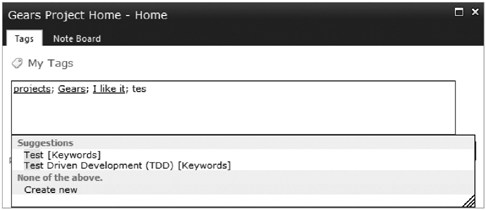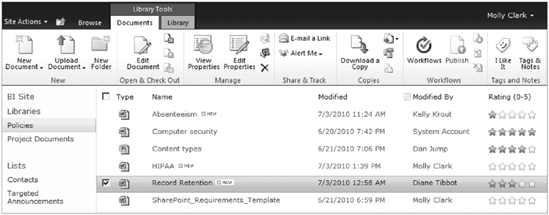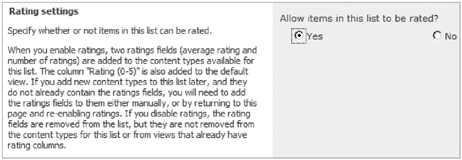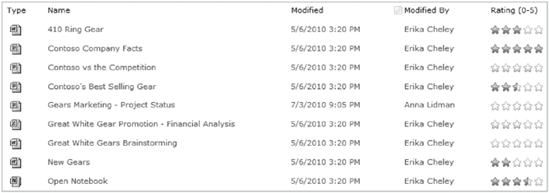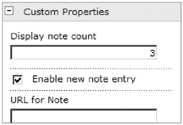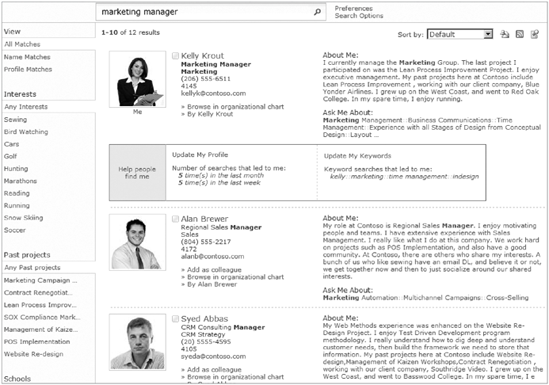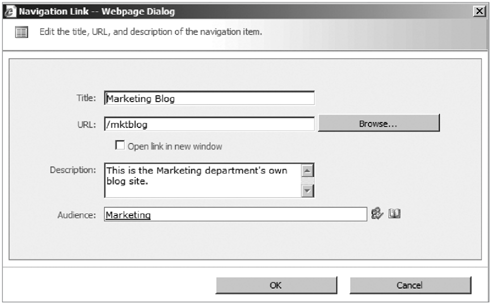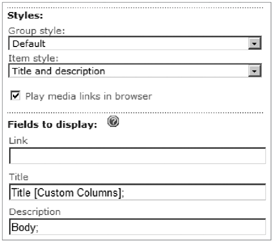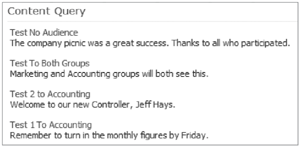WHAT YOU WILL LEARN IN THIS CHAPTER:
Some concepts regarding personalization and social networking, as well as how they can be beneficial in an organization
All of the aspects of SharePoint My Sites functionality with examples
The concepts of tagging, note boards, and ratings, as well as the new out-of-the-box web parts that are related to personalization features
The capabilities of blogs and wikis with a side-by-side comparison
The concept of targeting content to audiences, including the kinds of content that can be targeted, as well as how existing groups can be used as audiences
The term Web 2.0 represents a fundamental change in the Internet in the past 10 years or so, in the way we interact with applications, content, and other people. The web is now a platform for promoting a collective intelligence, and so is SharePoint 2010. The new methods of content creation and participation, such as blogs, tagging, and ratings, involve everyone in the enterprise in deeper and more meaningful ways.
In this chapter, you will learn how to make the most of the social networking tools that exist in SharePoint and how they apply to you. Also, you will be provided with several walk-through scenarios to try out.
Personalization and social networking tools are a powerful thing to put in the hands of business users. This chapter contains information related to how to work with the new social computing features, but before we get into the technical details, what is the big picture? In the grand scheme of things, what does Web 2.0 and social computing/networking mean to the company?
Inherently, SharePoint is a collaboration platform. You are not simply feeding read-only information to people, you are giving them their own locations to upload and edit team and project documents and much more. Engaging employees in SharePoint has been taken to a new level in SharePoint 2010. Notes, tags, and ratings can now be quickly added to content, which allows people to know that they have a hand in the creation and categorization of it. Each individual is now helping the online community in the organization by specifying which content they think has the greatest relevance and value.
Searching helps us find people and aggregate information. The rich and interactive search experience in SharePoint creates an environment where people can find and engage each other. When participation is encouraged, this actually improves search results, because the tags and ratings have an effect on the contents' search result ranking. Information workers typically spend a large part of their day searching for content. Getting the business community involved in tagging will shorten the amount of time that is spent searching, thus increasing company efficiency and productivity.
Knowledge mining is the concept of using the tags inside of user profiles to mine for areas of expertise in the organization. People are encouraged to fill out their own profile information with their skills and interests, which makes experts easier to find. For example, if a manager would like to put together a team for a new project to create a company policy system, a people search for "policies" would provide a list of potential additions to the team.
In social computing, there's an organic element of self-organization, also known as a user-generated taxonomy, or folksonomy. This transcends the traditional organizational hierarchy. This informal organization lacks the rigidity of an ineffective, management-imposed organizational tree. When people in the organization come to an understanding as to the power of the social computing tools in SharePoint 2010, they will realize how much their contributions as individuals have shaped the collective information.
When My Sites have been set up, each user in the organization gets their own landing page of SharePoint goings-on. This hub is where a list of the recent activities of colleagues is displayed; users can update their own personal information and store personal or shared files. My Site consists of My Newsfeed, My Content, and My Profile.
The My Profile page is where other people can read all about you. This page contains information about skills, projects you've worked on, ways to contact you, and a list of what you've been doing in SharePoint. Figure 11-1 shows the main page of My Profile.
In the preceding example, when Kelly Krout views her own profile, this is what she sees. The top portion of the page contains basic information about how she can be contacted. SharePoint 2010 now contains status updates, also known as microblogging. The text above Kelly's name that states "Looking forward to the big conference in October" is her current status. Users can each type their own current status here, in order to quickly let others know what they are up to. This same microblogging concept may be familiar as "Status updates" on Facebook, and as "tweets" on Twitter.
The following is a list of web parts that are displayed on the Overview tab on the My Site profile.
Ask Me About: These are links to topics that you want to encourage people to ask you about. When a link is clicked, such as Time Management in Figure 11-1, text is added to a new note in the Note Board on the page "Question on Time Management."
Recent Activities: This is a list of your most recent activities in SharePoint. Each activity contains a link to the item, such as a document that was tagged or rated.
My Organization Chart: The organization chart is a very simple, text version of the organization, including names and job titles. Click anyone's name to see their profile.
Note Board: The Note Board is a location where people can publicly post notes. In the context of the My Site, this is used to post quick notes as public messages to the owner of the site. Individuals receive email messages when others post notes to their note boards.
In Common With You: When viewing user profiles other than your own, this section displays colleagues and memberships that you have in common with that person. The first manager that you both share is displayed, as well as colleagues that you both know and the memberships that you both share.
This tab contains a dynamic Silverlight application called the Organization Browser, which shows a much more graphical and visual representation of the company structure. The structure itself is built automatically, based on the Manager field in each user's profile. Typically, this field is carried over to SharePoint from Active Directory (or other directory services), and is a read-only field in SharePoint profiles. The information in this organizational tree is only as accurate as the manager data in the company's directory. Figure 11-2 shows the Organization Browser, centered on Kelly Krout.
Each person's name, job title, department, and About Me information is displayed in their square. When you click from person to person in this application, the chart dynamically moves to center around the person clicked. Once someone is centered on the screen, click the person's name to see their profile page. To view this application in all its magnificence, the Silverlight browser plugin needs to be installed on client computers. Those without Silverlight should click the HTML View link at the bottom-left corner of the page.
This tab is a trimmed down version of your own My Content site. Only public content is available here. By default, your blog site, Shared Documents, and Shared Pictures are visible to anyone. To learn more about the permissions settings involved in shared versus public files, read Chapter 10. Figure 11-3 shows Kelly's Content tab when viewed by someone else.
Your social activities within SharePoint are logged and listed on the Tags and Notes tab. Others who are interested in your work can take a look at what you have done to participate in the tagging of information, and they can see your opinions as note board notes. This tab is also utilized by each person to manage his or her own stream of activity. When viewing your own Tags and Notes tab, you will see that each item has a Delete button next to it, and you also have the ability to switch public items to private. Private items are only visible to you. Figure 11-4 shows this tab as it is seen by someone else visiting your My Site.
Narrow down the view of activities on the right by clicking the refinement links on the left. You can refine by type, such as tags or notes, and even refine by the tags themselves. A tag cloud displays all of the tags that the person has used.
There is also a section called Add SharePoint Tags and Notes Tool. This tool provides a way to tag other Internet content that is not in SharePoint, and the instructions for using it are listed on the page.
Note
It is important to note that all tags and notes are ultimately managed by the SharePoint administrator, from Central Administration. In the User Profile Service Application, the administrator can perform searches by type, user, URL, date range, or keywords on the Manage Social Tags and Notes screen. The administrator can delete any content considered inappropriate.
In SharePoint, colleagues are those people whose activities you are following. SharePoint assumes that you are most interested in people whom you work most closely with, so they are automatically added to your list of colleagues. Direct reports and people who have a common manager will already be on the list. This information comes into SharePoint profiles and properties from a directory service such as Active Directory, and the connection is set up by the SharePoint administrator. On this tab, colleagues can be added, edited, and removed manually. Adding a colleague to your list does not automatically add your name to that person's list of colleagues.
Options on this tab are:
Add Colleagues: Multiple colleagues can be added at once. By default, each person that is added will receive an email notification letting them know.
Edit Colleagues: Select the checkbox next to one or more people, and click the Edit Colleagues button.
Remove Colleagues: Select the checkbox next to one or more colleagues, and click the Remove Colleagues button.
View Suggestions: Based on emails and instant messages that have been sent, and the organizational hierarchy, colleagues will be suggested by SharePoint.
This tab displays the person's group memberships, with information about each group. When someone is in the default "Members" SharePoint group on several sites, those are listed here. Also, email distribution lists are here, along with the total number of people in the group. Click any email distribution list's name to create a new email to that group. Select the checkbox next to one or more lists to modify their properties. Similarly to the way that the list of colleagues can be organized, these can be grouped and the Show To selection can be changed.
Profiles tell a lot about people, and their skills and interests. Individuals can edit their profile, and are encouraged to be thorough when it comes to Ask Me About, Projects, and Skills. Filling out a profile accurately is helpful when it comes to knowledge mining, so that when someone is searching for an expert, the right people will be found.
Figure 11-6 shows the top portion of Basic Information about Kelly Krout.
Some of the fields on the profile are editable, and some are not. These are called profile properties and are set up in Central Administration by the administrator. The Show To column is displayed down the right side of the page, and indicates who can see which information. Some of the Show To options are editable, and some are not.
Click the cursor inside of the About Me box to see the Format Text tab of the contextual Ribbon. The display of the information in this box can be customized to be more eye-catching, with font colors and sizes and the ability to edit the HTML code.
The Ask Me About information is an important part of making people findable in the organization. This is a list of proficiencies, and they are also tags that auto-fill as they are typed. The keywords typed here are displayed on the public profile, in the Ask Me About section of the Overview tab.
The Contact Information section of the profile lists the different methods by which you may be contacted. This screen can look different from organization to organization, because the SharePoint administrator configures the settings that determine which fields are read-only, required, or hidden. Notice that in the Show To column, some items have drop-down boxes, while other items are static. This, too is determined at the server level. Take a look at the Show To Options table in the previous section as a reference in deciding what the setting should be for each of these on your own profile. Figure 11-7 shows an example of the Contact Information section. Kelly has decided that only her manager can see her home phone number, all of her colleagues can see that she went to LSU, and everyone in the company can take a look at her past projects and skills.
All of the information that people share in profiles becomes part of SharePoint's searchable information. Social tags will be covered in detail later in this chapter, but it is important to understand that each of the words that appear as underlined are tags. These keywords are stored in a database in SharePoint, so that any other type of item in SharePoint that has been tagged with one of these words is now in a sense related to this individual profile. This all ties back to the concept of SharePoint 2010 as an organic and dynamic platform in the organization.
Further down the Edit My Profile page, there is a list of checkboxes within sections called Email Notifications and Activities I Am Following. The email notification options allow for granularly deciding what kinds of social activities that you would like to receive email notifications about. The Activities I Am Following checkboxes are options to narrow down the types of activities that you will see listed in your newsfeed.
Note
For the purpose of this book, most of the examples that have worked through will occur at the site level and on personal My Sites. If, after working through the chapter's activities, you are still looking for more in-depth administrative knowledge, it is recommended that you refer to the following SharePoint 2010 administrator book:
Professional SharePoint 2010 Administration, Chapter 17, "Social Computing and SharePoint 2010."
Each user gets a personal site collection called My Content, which is a link in the My Site toolbar. These sites can be customized by changing the theme, adding web parts, uploading content, and adding lists and libraries.
Note
The first time the My Content site is created there is small button on the page called "Set as default My Site." This button is above the Shared Documents web part. To get the full integration capabilities of Office and SharePoint, click this button. One of the benefits is that a My Site link will automatically be added to the left side of the Save As and Open screens in Office applications like Excel and Word.
When the site is first created, there will not be a blog yet, but the right side of the page has a quick link to create one. The Create Blog button is shown in Figure 11-8.
A new My Content site also contains some libraries in which to upload your own files. By default, everyone in the organization has read-only access to the Shared Documents and Shared Pictures libraries, and the Personal Documents library is only accessible to the site owner. Click Site Actions to create more libraries and lists on the site.
Chapter 7 covered web parts extensively. The My Content site is a great place to try out different out-of-the-box web parts, and there are even some that are made especially for this site.
Each person's newsfeed is their own stream of activities that they are following. These are things that are going on with people and topics that are of interest to the individual. Figure 11-9 shows an example of a newsfeed.
This hidden gem is perfect for saving favorite site locations inside or outside of SharePoint. My Links is a personal list that each user owns and manages, and is a bit hidden now in SharePoint 2010. This section will cover tasks like adding and managing links, and information about places where this list can be found. Links can also be categorized, and this is another place where the Show To box is used.
To tag objects in SharePoint is to assign keywords to them. The tags that are associated with any given item allow it to be found more readily when people in the organization perform searches that contain that tag. Note boards are areas where public comments can be posted about any given item. Participating in tagging and note boards is part of being an active member of the online community in your organization. In SharePoint 2010, everyone who visits the sites is encouraged to tag and make notes, which makes the experience organic and dynamic. Figure 11-14 shows the buttons that are used.
Where can you add tags and notes? Pretty much everywhere! The following is a list of some of the objects that you can tag.
Pages
Lists and Libraries
Documents
List Items
Blogs
Wikis
Images
Tag Profiles
Note
When working with libraries, the Tags & Notes buttons will not be available unless they have been turned on in the library settings. The owner of the library can click Document Library settings, and choose Enterprise Metadata and Keywords Settings. Check the box called Add Enterprise Keywords (a one-way operation), and check the box called Metadata Publishing. Click OK.
This section describes the tagging interface, as well as how tags are used and managed. When the I Like It button is clicked, this simply adds a tag called "I Like It" to that object. Click the Tags & Notes button to see the screen shown in Figure 11-15.
The title portion of the screen contains the name of the object being tagged. My Tags is a list of tags that the current user has added, and below it the Suggested Tags have already been added by other people. Recent Activities shows both tags and notes on the current item. Anyone can click the Private checkbox to set their own tags on that item to be visible only to themselves. When a new tag is added, click the Save button.
Any of the items in the Suggested Tags can be clicked to take further action. If that tag has not already been added to My Tags, there is an option to Add to My Tags. Each tag also has a tag profile, which will be covered in the next section.
Every tag in the organization exists in a database on the server and can be managed by administrators in the Term Store Management Tool. There is also a tag profile to represent each tag. The tag profile is a page where the tag information is displayed, as well as a list of every time the tag was used, and a note board just for that tag. The tag description, categorization, and synonyms have been set up by the administrator. Figure 11-16 is an example of a Tag Profile for a tag called "Customers – NDA."
The Get Connected section is a great tool for staying tuned in to all of the activities related to the tag.
Follow this tag in My Newsfeed: Click this button to add this tag to the list of interests in your profile. Tags that a user is interested in will be displayed on their Newsfeed.
Add to "Ask Me About" in My Profile: Add this tag to your own profile's Ask Me About section.
View people who are following this tag: Click this button to go to a search results page that displays all people who have this tag listed in their profile as responsibilities OR interests.
Use note boards to make quick public notes about any object in SharePoint. In the example in Figure 11-17, Anna Lidman is the currently logged-in user. Notice that Anna only has the ability to Edit or Delete her own notes, not those of others. Writing on a note board in SharePoint can be likened to posting to a "wall" on the Facebook website.
A new feature of SharePoint 2010 is the ability to rate items on a scale of one to five. Content rating is yet another mechanism for engaging all of the SharePoint users to participate on their sites, even if it simply involves clicking a star to quickly rate an item. Ratings can be used for any kind of list items, documents, and even wiki pages. When items are rated, this helps in determining their relevancy. SharePoint users will tend to lean more toward referencing documents that have more stars than to the ones with fewer, and the higher-rated items will be returned first in search results.
The settings page for any list or library has a link called Rating settings, as shown in Figure 11-20. This page describes what rating settings entails, with Yes and No radio buttons.
Note
It may take a while for newly added ratings to appear as blue stars next to the items that were rated. New ratings depend on a timer job on the server called the "User Profile Service Application – Social Rating Synchronization Job," which runs hourly by default.
There are several out-of-box web parts that make use of the SharePoint 2010 social computing features. These web parts can be added to any page, and add a dynamic aspect to the page. Chapter 7 has detailed information about how to work with web parts and about more of the out-of-box ones.
A tag cloud is a visual representation of a set of tags on a site. The tags are displayed by size, with the most frequently used tags being the largest. When this web part is added to a page, by default it only shows the current user's tags. The web part properties contain a setting called Show Tags, and it can be changed to show tags by all users. Figure 11-22 shows an example of a tag cloud web part.
Click on the name of any tag to go to its tag profile.
The organization browser is the same Silverlight web part that is seen on the Organization tab of the user profile. It can be inserted on any page and will automatically show the organization centered on the currently logged-in user. The only setting in this web part is to optionally change it to show the HTML view only.
The Note Board web part contains the same note board interface that is seen when clicking Tags & Notes at the top right of any page. This web part simply brings the notes themselves to the surface of the page. Figure 11-23 shows the configurable settings in the web part property tool pane.
The note count is the number of the most recent notes that are displayed, and the new note entry box is the big text box where new notes can be typed. Unchecking the Enable New Note entry frees up some real estate on the page, and new notes can still be added by clicking Tags & Notes at the top right. By default, this web part displays notes related to the current page, but a different URL can be entered in the URL for Note box if you would like to display the notes for any other object. For example, enter the URL to a document library to display that library's notes.
The information in each person's user profile is searchable in SharePoint 2010, with a greatly improved rich user interface and refinement panel. The more information that exists in the profiles, the more dynamic the people search experience will be. Figure 11-24 shows an example of a people results page. In this example, the currently logged-in user is Kelly Krout, and the search that was performed was "marketing manager."
The words in the search term are shown in bold on the page, where they appear in each person's profile. Since Kelly is the one performing the search, and her own name also came up in her search, there is an extra box called Help people find me. This lets Kelly know how many searches have led to her and the keywords that were used in the searches.
Down the left side of the screen, the refinement panel allows for quickly drilling down to narrow the search. These sections listed are properties in the users' profiles, such as interests, past projects, and schools.
Detailed contact information is listed about each person, along with quick links to add that person as a colleague or browse the organizational chart. Click the By Username link to see a list of recent documents and files that the person has worked on.
When the Internet began, it was mostly composed of static HTML pages, and web page creation required knowledge of code languages. In the past 10 years or so, the web has evolved to become a much more interactive experience, and it has become easy for everyone to become participants. Now, people are collaborating, discussing, and forming online communities around topics. These collaborations can combine data, content, images and multimedia from multiple sources to create personalized experiences.
A blog is a personal journal written on the web, originally called a "web log." Blogs can be written about any topic, ranging from daily life to information about a particular product, to opinions on politics. Within SharePoint in the enterprise, blogs are usually of a business-related nature. Here are a few blog concepts to be familiar with:
Blog posts: Using the concept of a blog being a journal, blog posts are the individual journal entries.
Comments: Blog readers may enter their own input about each blog post, for a running commentary.
Blog site: The blog site is the SharePoint site in which the blog posts and comments reside.
Blog account: The account comprises the URL to the blog site and the associated user login information.
"Wiki-wiki" is the Hawaiian word for quick. Wiki pages are web pages that can be quickly edited by typing directly into the browser. Use wikis to maintain a knowledge base, obtain community input on a topic, or simply to take personal notes.
Here are the major differences between blogs and wikis:
A blog is a whole site, whereas a wiki can be a wiki site or simply a wiki library on an already existing site.
Comments can be made on blogs, not wikis.
This table lists the items that can be inserted into a blog versus a wiki:
TYPE OF ITEM TO INSERT
BLOG
WIKI
Table
Yes
Yes
Picture
Yes
Yes
Video and Audio
No
Yes
Link
Yes
Yes
Upload File
Yes
Yes
Reusable Content
No
Yes
Web Part
No
Yes
Note
Team sites in SharePoint 2010 have a new feature called a Wiki Page Home Page. This means that the whole home page itself is a wiki page onto which images and text can be added directly to the page. The familiar buttons to Add a Web Part do not exist on these types of pages. Inserting a web part or anything else, is done from the Insert tab in the Ribbon. Here's how you can turn off the wiki page if necessary. Click Site Actions, choose Site Settings, and in the Site Actions section, click Manage site features. Click the Deactivate button next to the Wiki Page Home Page feature.
In SharePoint, audiences are used in order to target certain content to users, depending on information about them. Audiences are defined as groups of people who have certain attributes in common. For example, you can create a "Marketing" audience that includes everyone involved in the organization's marketing campaign. Content on a SharePoint page can be set up to be displayed to only members of a specific audience. Audience targeting is not the same as security, though. Just because an item is not targeted to a particular user, doesn't mean that the user will not be able to navigate to that item or find it in a search. Utilize targeting to personalize the page according to information about the logged-in user, so that any given person will automatically see the information that is relevant to them. In this section, you'll learn how to target content to audiences, and how to create new audiences.
In this section, you will learn about the five different ways to target content to audiences.
Audience targeting is an option in every list and library in SharePoint, but the content query web part is the only place that this item level targeting can be utilized. This means that items that are set up as targeted will still be displayed to everyone when they look at views of the list. Inserting the list or library as a web part on the page does not allow for the use of audiences, either.
Each individual web part on a page can be targeted to an audience. This helps to clean up the clutter of many web parts being presented, and helps to eliminate scrolling. Target each web part to only those users for whom the content is relevant. In the Web Part tool pane, expand the Advanced section. Target Audiences is the last option in this section, and the names of the audiences can be filled in here. Read more about Web Parts in Chapter 7.
Web part pages can only be targeted if audience targeting is enabled for the page library. In the library's settings, on the Audience targeting settings screen, check the box to Enable audience targeting. Each page's settings will have a box to fill in the names of the target audiences. In the site's navigation settings, when the Show Pages checkbox is selected, the pages that are displayed in navigation will be visible only to their target audiences.
When new links are manually created in the site's navigation settings, each link can be targeted to an audience. On the Navigation Settings page, click Add Heading or Add Link to see the page where the link's audience can be selected, as shown in Figure 11-26.
Note
Remember that, aside from any audience targeting, navigation items will automatically be security trimmed. This means that if you don't have access to a site, list, or library, you won't see it in the navigation.
Personalization Site Links are created by a SharePoint administrator and are links that are only displayed in the top navigation of personal sites, such as My Site and My Content. Use these types of links in order to target links to specific groups of people. Although an owner's name is required for each link, it is not tied to any type of security. The owner's name is used purely for informational purposes. In Central Administration, under a service application called the User Profile Service Application, click Configure Personalization Site to create these links.
Also in the User Profile Service Application, these types of links can be created for use in Microsoft Office applications such as Word and Excel. When links are created here, users in the target audiences will see their links in Office when viewing the Open or the Save As screens.
There is a way to create and define audiences at a global level, by an administrator, but this is not required in order to make use of audiences. Active Directory or SharePoint groups can be used as audiences. The following table compares the different methods of targeting content to show what kinds of audiences can be utilized with each one. This is useful when determining when it may or may not be necessary to elicit the help of the SharePoint Administrator.
SharePoint Administrators can create global audiences, which are rules-based. These are created from within Central Administration and can be applied to any of the types of targeted content. Use these types of audiences when a SharePoint Group or Distribution list is not sufficient for defining the list of users who should exist in an audience.
Creating global audiences is a matter of first defining the group of people and then creating a set of rules to pull them into the audience. Audiences are composed of properties and rules; after they are assembled, they must be all be compiled on one schedule.
The audience properties consist of a name, description, and owner's name. The owner's name is used for documentation purposes only and is not related to any type of permissions. There is also a very important choice to be made, called Include users who, where there are two options. Choose "Satisfy all of the rules" in a case where the audience is very specific. Choose "Satisfy any of the rules" in situations where the audience should include as many users as possible.
Many rules can be added to any audience. Each time a new rule is created, there are two different types of rules to choose from, which are referred to as operands. The User operand lets you select either the name of the person that the user reports to, or the name of a directory group or distribution list that they are a member of. The Property operand contains a list of many user properties, such as Department, Office, Job Title, and a host of others. In Figure 11-30, an audience called Accounting has been created. Since the audience's creator would like to encompass as many people as possible in this audience, it has been set up to include any user who satisfies any of the rules.
Set up a compilation schedule for all audiences. During a compilation, all of the users in SharePoint are examined to check to see if they meet the defined rules. In this case, if there is a new person in the Accounting department, he or she will be placed in this audience during the next compilation. The Schedule Audience Compilation link is on the User Profile Service Application screen.
There is a plugin that comes with Outlook 2010, called the Social Connector. This allows you to configure Outlook to display information from the various social networks that you are a member of. The SharePoint 2010 network is included by default, but others that can be added are LinkedIn and My Space.
When a social network is added, a new contacts list is added to Outlook, importing the contacts from each network. When corresponding with these individuals, a People Pane appears at the bottom of the page. This pane contains information such as the person's picture, along with a quick list of the most recent activity associated with that person, such as emails and calendar appointments.
In Outlook 2010, click the View tab in the Ribbon, and click the People Pane button. Choose Account Settings in order to set up your list of social networks.
Personalization and social networking in SharePoint 2010 are fundamental aspects of how people will share, categorize, and find information. In this chapter, you learned why these social concepts are important and how they are applied in the organization. You also learned how to go about making use of these tools as part of day-to-day work in SharePoint. The more people that get involved in social computing in your company, the easier it will be to find content and people. When people participate and feel like they are making a contribution to the community of the organization, they will not only be more efficient at their jobs, but will feel valued as individuals.

